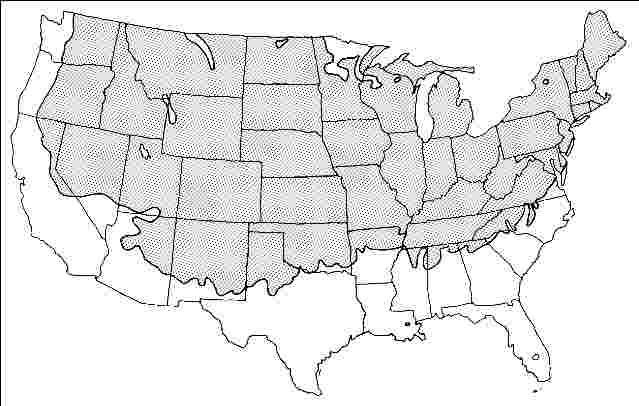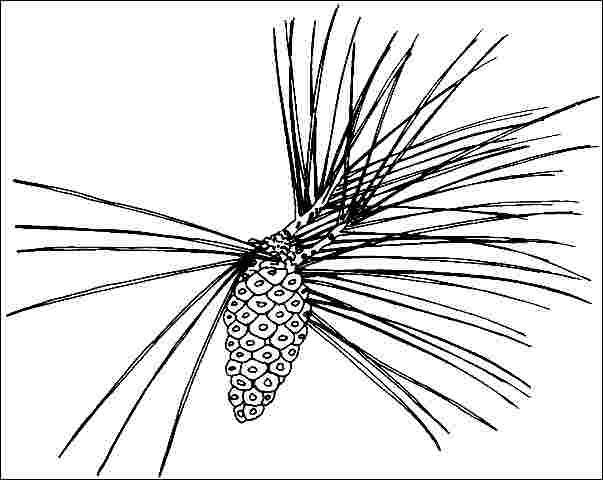Introduction
Japanese red pine reaches a height and spread of 30 to 50 feet in the landscape, growing much taller in the woods. Needles are arranged in pairs and remain on the tree for about three years. The needles on this cultivar have a light-yellow color and they have been described by some people as off-color. A distinguishing feature of this tree is the often crooked or sweeping trunk which shows reddish-orange peeling bark. Because lower branches are held nearly horizontal on the trunk forming a picturesque silhouette in the landscape, it is used best as a specimen, not as a mass planting. Needles may turn yellowish during winter on some soils.

Credit: UF/IFAS
General Information
Scientific name: Pinus densiflora
Pronunciation: PIE-nus den-sih-FLOR-uh
Common name(s): 'Aurea' Japanese red pine
Family: Pinaceae
USDA hardiness zones: 3A through 7B (Figure 2)
Origin: not native to North America
Invasive potential: not assessed/incomplete assessment
Uses: Bonsai; specimen

Credit: UF/IFAS
Description
Height: 30 to 50 feet
Spread: 35 to 50 feet
Crown uniformity: irregular
Crown shape: oval
Crown density: moderate
Growth rate: moderate
Texture: fine
Foliage
Leaf arrangement: alternate
Leaf type: simple
Leaf margin: entire
Leaf shape: needle-like (filiform)
Leaf venation: parallel
Leaf type and persistence: needled evergreen, evergreen, fragrant
Leaf blade length: 2 to 4 inches, 4 to 8 inches
Leaf color: yellow
Fall color: no color change
Fall characteristic: not showy
Flower
Flower color: yellow
Flower characteristics: not showy
Fruit
Fruit shape: oval, cone
Fruit length: 1 to 3 inches
Fruit covering: dry or hard
Fruit color: tan
Fruit characteristics: does not attract wildlife; not showy; fruit/leaves a litter problem

Credit: UF/IFAS
Trunk and Branches
Trunk/bark/branches: branches don't droop; showy; typically multi-trunked; thorns
Pruning requirement: needed for strong structure
Breakage: susceptible to breakage
Current year twig color: green
Current year twig thickness: medium
Wood specific gravity: unknown
Culture
Light requirement: full sun
Soil tolerances: clay; sand; loam; acidic; well-drained
Drought tolerance: moderate
Aerosol salt tolerance: low
Other
Roots: not a problem
Winter interest: yes
Outstanding tree: yes
Ozone sensitivity: unknown
Verticillium wilt susceptibility: resistant
Pest resistance: resistant to pests/diseases
Use and Management
The tree prefers a site with full sun and a well-drained, slightly acid soil. Clay soil is usually not suitable unless the site is well drained, such as on a slope.
There are a few other cultivars: ‘Alboterminata'—yellowish needle tips; ‘Oculis-draconis'—Dragon's Eye Pine—two yellow lines on needles; ‘Umbraculifera'—Tanyosho Pine—20 feet tall, multi-trunked, and perhaps the most popular cultivar.
Propagation is by seed.
Pests
This tree is usually pest-free, with occasional scale, but the list of potential problems is long.
Some adelgids will appear as white cottony growths on the bark. All types produce honeydew which may support sooty mold. European pine shoot moth causes young shoots to fall over. Infested shoots may exude resin. The insects can be found in the shoots during May. Pesticides are only effective when caterpillars are moving from overwintering sites to new shoots. This occurs in mid to late April or when needle growth is about half-developed.
Bark beetles bore into trunks making small holes scattered up and down the trunk. Stressed trees are more susceptible to attack. The holes look like shotholes. Keep trees healthy.
Sawfly larvae caterpillars are variously colored but generally feed in groups on the needles. Some sawfly larvae will flex or rear back in unison when disturbed. Sawflies can cause rapid defoliation of branches if left unchecked.
Pine needle miner larvae feed on the inside of needles causing them to turn yellow and dry up.
Pine needle scale is a white, elongated scale found on the needles. Pine tortoise scale is brown and found on twigs. Depending on the scale, horticultural oil may control overwintering stages.
Pine spittle bug lives and hides in a foamy mass.
Spruce mites cause damage to older needles and are usually active in the spring and fall. Mites cause older needles to become yellowed or stippled.
Zimmerman pine moth larvae bore into the trunk. The only outward symptoms may be death of parts of the tree or masses of hardened pitch on the branches.
The larvae of pine weevils feed on the sapwood of the leaders. The leader is killed and the shoots replacing it are distorted. First symptoms are pearl white drops of resin on the leaders. The leaders die when the shoot is girdled as adults emerge in August. Prune out and burn infested terminals before mid-July.
Pine wilt nematode can cause considerable damage.
Diseases
They are susceptible to needle blight, rusts. Canker diseases may cause dieback of landscape pines. Keep trees healthy and prune out the infected branches.
Needle cast is common on small trees and plantation or forest trees. Infected needles yellow and fall off.